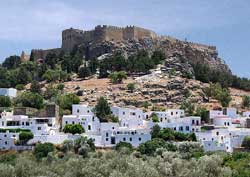Lindos Acropolis
 Why the
Lindos Acropolis
in the Greek Islands
is special
Why the
Lindos Acropolis
in the Greek Islands
is specialThe Lindos Acropolis (see upper part of photo) is perched dramatically on a promontory in southern Greece. It's a beautifully stunning sight I will never forget.
Lindos Acropolis tips and insights
Most famous part
The Temple of Athena is the most celebrated building. However, it's the walls surrounding the Lindos Acropolis that visual define the site to tourists and professional photographers.
Architecture
The Lindos Acropolis is a sprawling complex of structures. Many different building styles are evident. This reflects the many cultures that held sway at different periods over the Lindos Acropolis. These include Classical Greek, Hellenistic, Roman and Byzantine. Today, the Hellenistic influence is the most obvious.
Knights of St John
The massive walls were built by the Knights of St. John, which governed Rhodes Island in southern Greece for many years.
Name
"Acropolis" means high city in Greek. Other acropolises exist (or once existed), including the world famous one in Athens.
Cliffs
The seaside cliffs on two sides are as high as a 30-story building and drop precipitously to the sea.
Views
Your hard climb is rewarded by more than seeing the ruins. Below you is a vista of one of the Greek Islands' most attractive seascapes, You also view the bayside village of Lindos.
Village
Allow time to visit the village of Lindos. It has charming whitewashed dwellings and a sandy beach. Be sure to explore its twisting, exceptionally narrow lanes. In some places, it's difficult to pass a person without turning sideways.
Reaching the Lindos Acropolis from the village
You can do it only by foot or (for part of the way) by donkey. The last part of the trek is the hardest and is beyond the donkey's reach. You must climb a long, steep stairway with the hot sun beating down on your head (wear a hat).
Hazard
Some of the stones underfoot have been worn slippery smooth through centuries of use. So wear comfortable shoes with good traction. And be especially careful when rain makes the stones slippery.


